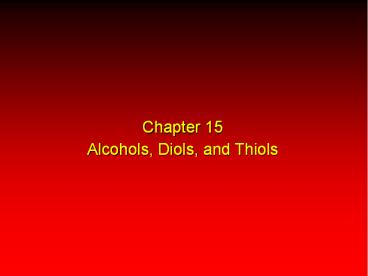Chapter 15 Alcohols, Diols, and Thiols - PowerPoint PPT Presentation
Title:
Chapter 15 Alcohols, Diols, and Thiols
Description:
Most alcohols with five or six carbons are. readily available. Other alcohols ... syn addition of OH groups to each carbon. of double bond. Osmium Tetraoxide ... – PowerPoint PPT presentation
Number of Views:67
Avg rating:3.0/5.0
Title: Chapter 15 Alcohols, Diols, and Thiols
1
Chapter 15Alcohols, Diols, and Thiols
2
15.1Sources of Alcohols
3
Methanol
- Methanol is an industrial chemical
- end uses solvent, antifreeze, fuel
- principal use preparation of formaldehyde
4
Methanol
- Methanol is an industrial chemical
- end uses solvent, antifreeze, fuel
- principal use preparation of formaldehyde
- prepared by hydrogenation of carbon monoxide
CO 2H2 Æ CH3OH
5
Ethanol
- Ethanol is an industrial chemical
- Most ethanol comes from fermentation
- Synthetic ethanol is produced by hydrationof
ethylene - Synthetic ethanol is denatured (madeunfit for
drinking) by adding methanol, benzene,pyridine,
castor oil, gasoline, etc.
6
Other alcohols
- Isopropyl alcohol is prepared by hydration of
propene. - All alcohols with four carbons or fewer are
readily available. - Most alcohols with five or six carbons are
readily available.
7
Sources of alcohols
Reactions discussed in earlier chapters (Table
15.1)
- Hydration of alkenes
- Hydroboration-oxidation of alkenes
- Hydrolysis of alkyl halides
- Syntheses using Grignard reagents organolithium
reagents
8
Sources of alcohols
New methods in Chapter 15
- Reduction of aldehydes and ketones
- Reduction of carboxylic acids
- Reduction of esters
- Reaction of Grignard reagents with epoxides
- Diols by hydroxylation of alkenes
9
15.2Preparation of AlcoholsbyReduction of
Aldehydes and Ketones
10
Reduction of Aldehydes Gives Primary Alcohols
11
Example Catalytic Hydrogenation
Pt, ethanol
(92)
12
Reduction of Ketones Gives Secondary Alcohols
R
C
O
R'
13
Example Catalytic Hydrogenation
H
OH
Pt
H2
ethanol
(93-95)
14
Retrosynthetic Analysis
H
H
15
Metal Hydride Reducing Agents
Sodiumborohydride
Lithiumaluminum hydride
- act as hydride donors
16
Examples Sodium Borohydride
Aldehyde
NaBH4
CH2OH
methanol
(82)
Ketone
NaBH4
ethanol
(84)
17
Lithium aluminum hydride
- more reactive than sodium borohydride
- cannot use water, ethanol, methanol etc.as
solvents - diethyl ether is most commonly used solvent
18
Examples Lithium Aluminum Hydride
Aldehyde
1. LiAlH4diethyl ether
CH3(CH2)5CH2OH
2. H2O
(86)
Ketone
1. LiAlH4diethyl ether
(C6H5)2CHCCH3
2. H2O
(84)
19
Selectivity
- neither NaBH4 or LiAlH4reduces isolateddouble
bonds
1. LiAlH4diethyl ether
2. H2O
(90)
20
15.3Preparation of Alcohols By Reductionof
Carboxylic Acids and Esters
21
Reduction of Carboxylic AcidsGives Primary
Alcohols
R
C
O
HO
- lithium aluminum hydride is only effective
reducing agent
22
Example Reduction of a Carboxylic Acid
1. LiAlH4diethyl ether
2. H2O
(78)
23
Reduction of EstersGives Primary Alcohols
- Lithium aluminum hydride preferred forlaboratory
reductions - Sodium borohydride reduction is too slowto be
useful - Catalytic hydrogenolysis used in industrybut
conditions difficult or dangerous to duplicate
in the laboratory (special catalyst,
hightemperature, high pressure
24
Example Reduction of a Carboxylic Acid
25
15.4Preparation of Alcohols From Epoxides
26
Reaction of Grignard Reagentswith Epoxides
R
CH2
CH2
OMgX
H3O
RCH2CH2OH
27
Example
CH2
H2C
CH3(CH2)4CH2MgBr
O
1. diethyl ether 2. H3O
CH3(CH2)4CH2CH2CH2OH
(71)
28
15.5Preparation of Diols
29
Diols are prepared by...
- reactions used to prepare alcohols
- hydroxylation of alkenes
30
Example reduction of a dialdehyde
H2 (100 atm)
Ni, 125C
3-Methyl-1,5-pentanediol
(81-83)
31
Hydroxylation of AlkenesGives Vicinal Diols
- vicinal diols have hydroxyl groups on adjacent
carbons - ethylene glycol (HOCH2CH2OH) is most familiar
example
32
Osmium Tetraoxide is Key Reagent
- syn addition of OH groups to each carbonof
double bond
33
Example
(73)
34
Example
(CH3)3COOHOsO4 (cat)
tert-Butyl alcoholHO
(62)































